Ad
व्हील एलाइनमेंट और बैलेंसिंग का महत्व
व्हील अलाइनमेंट और बैलेंसिंग टायर पहनने, बेहतर हैंडलिंग और स्मूथ राइड के लिए भी महत्वपूर्ण हैं। वाहन की सेहत के लिए इसे हर 5,000-6,000 मील पर करें।
आपके पास जो वाहन है वह एक जटिल प्रणाली है जिसमें कई अंतर-निर्भर हिस्से होते हैं। यदि कोई हिस्सा क्षतिग्रस्त हो जाता है, तो यह केवल कुछ समय पहले की बात है जब समस्या अन्य जुड़े भागों को भी प्रभावित करना शुरू कर देती है और इससे कुछ गंभीर खराबी हो सकती है। गलत व्हील अलाइनमेंट और बैलेंसिंग एक ऐसी समस्या है, जो सस्पेंशन को नुकसान पहुंचाकर और टायर के स्वास्थ्य को प्रभावित करके आपकी कार के संचालन के दौरान गंभीर समस्याएं पैदा कर सकती
है।
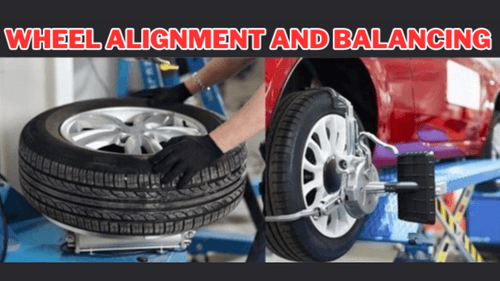
Ad
Ad
| सेवाएँ | परिभाषा | संकेत है कि यह समय है | फ़ायदे |
|---|---|---|---|
| व्हील अलाइनमेंट | व्हील अलाइनमेंट में पहियों के कोणों को ठीक किया जाता है ताकि पहिए सही तरीके से सड़क से मिल सकें। | यदि वाहन को एक तरफ खींच लिया जाता है, तो सीधे वाहन चलाते समय तेजी से टायर घिस जाते हैं, टायरों का चीखना या टेढ़ा स्टीयरिंग व्हील हो जाता है। | उचित संरेखण यह सुनिश्चित करता है कि सवारी आपके लिए आसान हो और आपके टायरों की आयु लंबी हो। |
| बैलेंसिंग | व्हील बैलेंसिंग का इस्तेमाल आपके टायरों पर वज़न के असंतुलन को ठीक करने और व्हील को असेंबल करने के लिए किया जाता है. | टायरों का असमान घिसा-पिटा होना और आपके स्टीयरिंग व्हील, फ्लोरबोर्ड या सीट में कंपन। | उचित संतुलन से सवारी आसान हो सकती है, क्योंकि टायर कम घिसते हैं, और ड्राइवट्रेन पर तनाव कम होता है। |
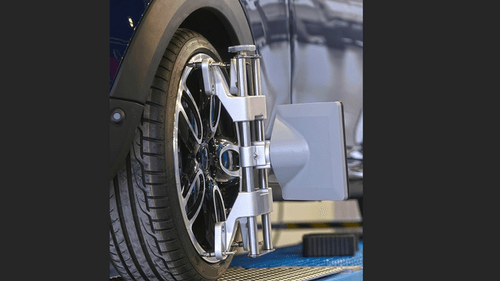
व्हील अलाइनमेंट को टायर अलाइनमेंट के रूप में भी जाना जाता है, और यह आपके व्हील को ठीक से प्रदर्शन करने में मदद कर सकता है और इसे थोड़ी देर तक चलने में मदद कर सकता है। यह हैंडलिंग में भी सुधार करता है और आपके वाहन को केवल एक दिशा में खींचने या सड़क पर अजीब तरह से कंपन करने से बचाता
है।
व्हील अलाइनमेंट क्या है?
संरेखण या पहिया संरेखण वाहन के निलंबन के समायोजन को संदर्भित करता है, जो कि पहियों को वाहन से जोड़ने वाली प्रणाली है। यह स्वयं टायरों या पहियों का समायोजन नहीं है, उचित संरेखण की कुंजी उन कोणों को समायोजित करना है जिन पर सड़क से संपर्क बनाने के लिए पहिए या टायर स्थित हैं। पहियों को एडजस्ट करते समय मैकेनिक या तकनीशियन निम्नलिखित तीन चीजों की जांच करता है,
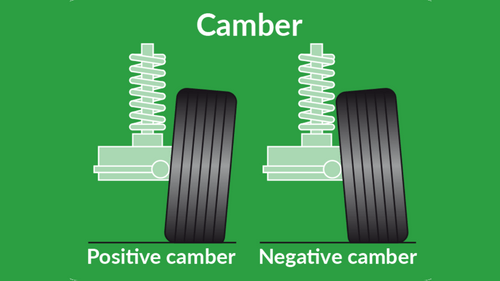
- कैम्बर: - कैम्बर मिसलिग्न्मेंट खराब बेयरिंग, बॉल जॉइंट्स और अन्य सस्पेंशन पार्ट्स के कारण होता है, जिसके परिणामस्वरूप वाहन के सामने से देखने पर टायरों का अंदर या बाहर की ओर झुकाव होता है। बहुत अधिक आवक या जावक झुकाव को नकारात्मक और सकारात्मक कैम्बर के रूप में भी जाना जाता है, जो अनुचित संरेखण और समायोजन की जरूरतों को दर्शाता है। चूंकि वाहन के उचित प्रदर्शन के लिए पहिए का उचित संरेखण महत्वपूर्ण है।
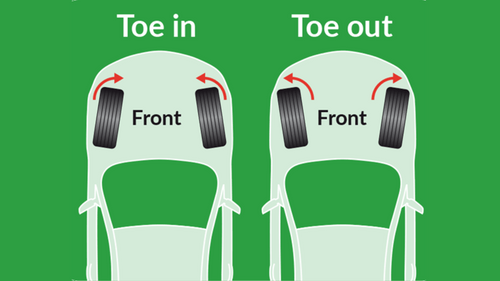
- पैर की
- अंगुली: - पैर की अंगुली का संरेखण ऊपर से देखने पर आपकी कार के पहियों के अंदर या बाहर की ओर मुड़ने को संदर्भित करता है। यह कैम्बर अलाइनमेंट से अलग है, क्योंकि यह वह सीमा है जिस तक आपके टायर अंदर या बाहर की ओर मुड़ते हैं। जब आपके पैर आपके शरीर के केंद्र की ओर अंदर की ओर झुके होते हैं, तो यह पैर के अंगूठे का संरेखण होता है, और जब आपके पैर बाहर की ओर झुके होते हैं तो इसके विपरीत या इसके विपरीत जब आपके पैर बाहर की ओर झुकते हैं, तो यह पैर के अंगूठे से बाहर की ओर संरेखण होता है। दोनों ही मामलों में समायोजन की आवश्यकता होती है।
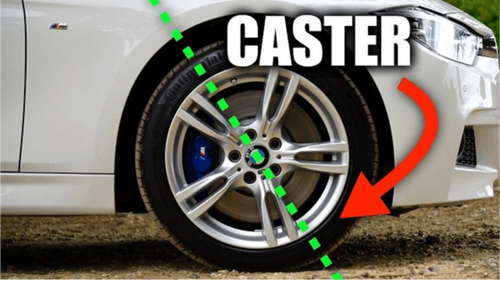
- कास्टर: - वाहन में स्टीयरिंग, स्थिरता और कॉर्नरिंग को संतुलित करने के लिए कास्टर एंगल एक महत्वपूर्ण कारक है। यदि स्टीयरिंग अक्ष चालक की ओर झुका हुआ है, तो यह एक सकारात्मक ढलाईकार है और यदि यह वाहन के सामने की ओर झुका हुआ है तो यह एक नकारात्मक ढलाईकार है।
मुझे कैसे पता चलेगा कि मुझे टायर या व्हील अलाइनमेंट की आवश्यकता है?
ऐसे कुछ तरीके हैं जो आपको बता सकते हैं कि आपकी कार को टायर अलाइनमेंट की जरूरत है या नहीं। यदि आपने नीचे दिए गए इन उल्लिखित संकेतकों में से किसी एक या एक से अधिक पर ध्यान दिया है, तो आपको एक ही बार में लाइसेंस प्राप्त सेवा तकनीशियन द्वारा अपने संरेखण की जांच करवानी चाहिए
।
- असमान ट्रेड वियर होने की स्थिति में
- यदि वाहन बाईं या दाईं ओर खींच रहा है
- अगर आप सीधे गाड़ी चला रहे हों तो आपका स्टीयरिंग व्हील ऑफ सेंटर है
- यदि स्टीयरिंग व्हील कंपन है
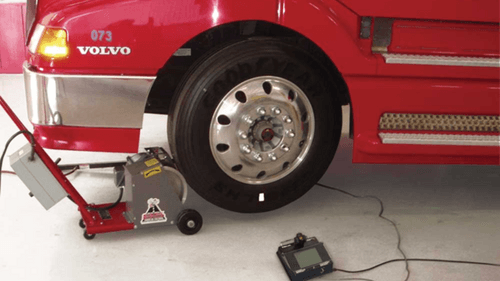
व्हील बैलेंसिंग और व्हील अलाइनमेंट अक्सर भ्रमित होते हैं, लेकिन वे समान नहीं होते हैं। सुचारू ड्राइविंग, स्थिरता और कार के टायरों की सुरक्षा के लिए व्हील बैलेंसिंग आवश्यक है। यह व्हील और टायर कॉम्बो में वज़न के असंतुलन की भरपाई करता है। आधुनिक व्हील बैलेंसर मशीनें गतिशील और स्थिर संतुलन दोनों की गणना एक साथ कर सकती हैं। टायर बैलेंसिंग पहियों में वजन के असमान वितरण को ठीक करता है, कंपन, अत्यधिक टायर घिसने और सस्पेंशन से होने वाले नुकसान को रोकता है। टायर बैलेंस सर्विस के दौरान, असंतुलन को मापने और सही टायर वेट लगाने के लिए मशीन पर टायर और पहिए लगाए जाते हैं। व्हील बैलेंसिंग और अलाइनमेंट को एक समान रूप से भ्रमित नहीं किया जाना चाहिए, भले ही
वे एक साथ किए गए हों।
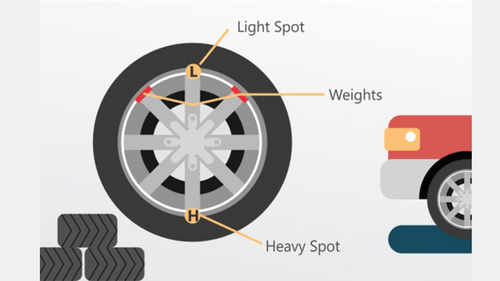
कई तकनीशियन इस बात से सहमत हैं कि हर 5000 से 6000 मील पर अपने टायरों को संतुलित करने से आपको टायरों के जीवनकाल को बढ़ाने और उनके प्रदर्शन को बेहतर बनाने में मदद मिल सकती है। दूसरी ओर, व्हील अलाइनमेंट के लाभों में वाहनों की बेहतर हैंडलिंग, ईंधन की दक्षता और टायरों के जीवनकाल में सुधार शामिल
हैं।
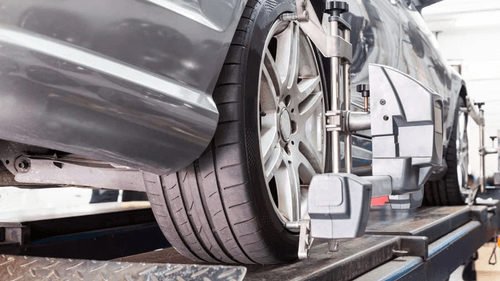
संतुलित वाहन बनाए रखने के लिए व्हील बैलेंसिंग महत्वपूर्ण है। चूंकि असमान टायर खराब हो जाता है और स्टीयरिंग व्हील, फ्लोरबोर्ड या सीट में कंपन यह दर्शाता है कि पहियों को संतुलित करने की आवश्यकता है। व्हील के रोटेशन, फ्लैट टायर रिपेयर या शेड्यूल किए गए मेंटेनेंस के दौरान बैलेंसिंग की जा सकती है। स्टीयरिंग व्हील में कांपने वाले हिस्सों से पता चलता है कि आगे के टायर में असंतुलन है, जबकि सीटों से संकेत मिलता है कि पीछे के पहियों में असंतुलन है। टायर के असमान घिसने, पहियों के वजन में कमी या लंबे समय तक पार्किंग से सपाट स्थानों के कारण टायर या व्हील में असंतुलन हो सकता
है।
संतुलन और संरेखण से आपकी कार को क्या लाभ होता है?
बैलेंसिंग सेवाओं के सबसे महत्वपूर्ण लाभों में से एक यह है कि वे समय से पहले टायर को घिसने से रोकते हैं। तकनीशियन इस बात से भी सहमत हैं कि हर 5000 — 6000 मील के बाद अपने टायरों को संतुलित करने से टायरों के जीवनकाल को बढ़ाने में मदद मिल सकती है और साथ ही उनके प्रदर्शन में भी सुधार हो सकता है
।
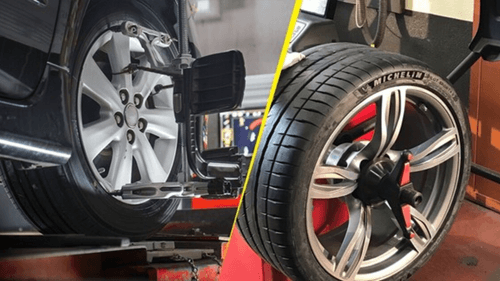
है।
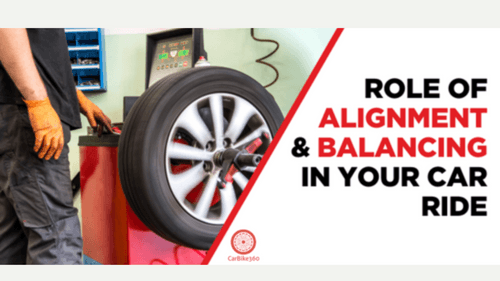
नियमित पहिया संरेखण और संतुलन रखरखाव की आवश्यक प्रथाएं हैं जो आपके वाहन के लिए कई लाभ प्रदान करती हैं और आपके ड्राइविंग अनुभव को बेहतर बनाती हैं। अपने पहियों को पूरी तरह से संतुलित और संतुलित रखने के कुछ प्रमुख लाभ नीचे दिए गए हैं
:
- टायर
के जीवनकाल को बेहतर बनाता है: नियमित व्हील अलाइनमेंट सुनिश्चित करता है कि टायर घिसना समान रूप से वितरित हो, जिससे अत्यधिक या असमान घिसाव और समय से पहले टायर बदलने से बचा जा सके। नियमित संरेखण समय से पहले खराब होने से और समय से पहले टायर बदलने से रोककर टायर के जीवनकाल को भी बढ़ाता है।
बढ़ी हुई ईंधन दक्षता: जब आपके पहिए गलत संरेखित होते हैं, तो आपके वाहन को रोलिंग प्रतिरोध में वृद्धि का अनुभव हो सकता है, जिससे वह अधिक मेहनत कर सकता है और अधिक ईंधन की खपत कर सकता है। लेकिन उचित संरेखण इस तरह के प्रतिरोध को कम करता है, जिससे ईंधन दक्षता में सुधार होता है और समय के साथ लागत की
बचत होती है।आसान और सुरक्षित सवारी: उचित रूप से संरेखित पहिए ड्राइविंग आराम को बढ़ाते हैं, कंपन को कम करते हैं और वाहन की हैंडलिंग में सुधार करते हैं। यह समग्र सुरक्षा में योगदान देता है, विशेष रूप से चुनौतीपूर्ण सड़क स्थितियों के दौरान, और चुनौतीपूर्ण परिस्थितियों में समग्र सुरक्षा को बढ़ाता है
।यांत्रिक तनाव में कमी: गलत संरेखित पहिए वाहन के विभिन्न घटकों, जैसे सस्पेंशन और स्टीयरिंग पार्ट्स पर अनावश्यक दबाव डालते हैं। नियमित संरेखण इस तरह के तनाव को कम करता है जिससे मरम्मत की लागत कम हो जाती है और पुर्जे लंबे समय तक चलते
हैं।कंपन और शोर को कम करता है: आपके पहियों को संतुलित करने से टायर के असंतुलित होने पर होने वाले कष्टप्रद कंपन और शोर समाप्त हो जाते हैं। टायरों को संतुलित करने से सवारी आसान और शांत होती है, जो समग्र रूप से आरामदायक ड्राइव में योगदान करती है
।
निष्कर्ष
अंत में, यह कहा जा सकता है कि वाहन के सुरक्षित और सुचारू प्रदर्शन को सुनिश्चित करने के लिए व्हील अलाइनमेंट और व्हील बैलेंसिंग दोनों महत्वपूर्ण रखरखाव सेवाएं हैं। व्हील अलाइनमेंट टायरों के एंगल और सस्पेंशन कंपोनेंट्स को एडजस्ट करने की प्रक्रिया है, ताकि यह सुनिश्चित किया जा सके कि टायर जमीन के लंबवत और एक दूसरे के समानांतर हों। जबकि व्हील बैलेंसिंग यह सुनिश्चित करने की प्रक्रिया है कि टायरों और असेंबल किए गए व्हील का वजन समान रूप से वितरित किया जाए। टायरों के जीवनकाल को अधिकतम करने, ईंधन की दक्षता में सुधार करने और कंपन को कम करने के लिए दोनों सेवाएं महत्वपूर्ण हैं
।
और लेख
भारत में शीर्ष 10 प्रीमियम इलेक्ट्रिक वाहन और खरीदने के लिए सर्वश्रेष्ठ लक्जरी ईवी
भारत में शीर्ष 10 प्रीमियम इलेक्ट्रिक वाहनों का अन्वेषण करें, जो लक्जरी, प्रदर्शन और अत्याधुनिक तकनीक प्रदान करते हैं। Audi, BMW, Mercedes, Porsche आदि जैसे ब्रांडों के सर्वश्रेष्ठ EV खोजें।
03-अप्रैल-2025 07:39 हूँ
पूरा लेख पढ़ेंभारत में शीर्ष 10 प्रीमियम इलेक्ट्रिक वाहन और खरीदने के लिए सर्वश्रेष्ठ लक्जरी ईवी
भारत में शीर्ष 10 प्रीमियम इलेक्ट्रिक वाहनों का अन्वेषण करें, जो लक्जरी, प्रदर्शन और अत्याधुनिक तकनीक प्रदान करते हैं। Audi, BMW, Mercedes, Porsche आदि जैसे ब्रांडों के सर्वश्रेष्ठ EV खोजें।
03-अप्रैल-2025 07:39 हूँ
पूरा लेख पढ़ेंइलेक्ट्रिक बाइक और पारंपरिक बाइक इंश्योरेंस में क्या अंतर है?
इलेक्ट्रिक बनाम पारंपरिक बाइक इंश्योरेंस कवरेज, लागत और बैटरी सुरक्षा की तुलना करें। जानें कि सबसे अच्छी फाइनेंशियल सुरक्षा के लिए कौन सी पॉलिसी आपके टू-व्हीलर की ज़रूरतों के हिसाब से सही है।
08-मार्च-2025 05:12 हूँ
पूरा लेख पढ़ेंइलेक्ट्रिक बाइक और पारंपरिक बाइक इंश्योरेंस में क्या अंतर है?
इलेक्ट्रिक बनाम पारंपरिक बाइक इंश्योरेंस कवरेज, लागत और बैटरी सुरक्षा की तुलना करें। जानें कि सबसे अच्छी फाइनेंशियल सुरक्षा के लिए कौन सी पॉलिसी आपके टू-व्हीलर की ज़रूरतों के हिसाब से सही है।
08-मार्च-2025 05:12 हूँ
पूरा लेख पढ़ेंन केवल मोबाइल, बल्कि आपकी कार भी आपकी बात सुन रही है - और आपका डेटा बेचा जा रहा है
वॉइस कमांड से लेकर कॉल हिस्ट्री तक, आपकी कार आपके विचार से अधिक डेटा एकत्र कर सकती है। जानें कि इस जानकारी का उपयोग कैसे किया जाता है और अपनी गोपनीयता को कैसे सुरक्षित रखा जाए।
06-मार्च-2025 05:52 हूँ
पूरा लेख पढ़ेंन केवल मोबाइल, बल्कि आपकी कार भी आपकी बात सुन रही है - और आपका डेटा बेचा जा रहा है
वॉइस कमांड से लेकर कॉल हिस्ट्री तक, आपकी कार आपके विचार से अधिक डेटा एकत्र कर सकती है। जानें कि इस जानकारी का उपयोग कैसे किया जाता है और अपनी गोपनीयता को कैसे सुरक्षित रखा जाए।
06-मार्च-2025 05:52 हूँ
पूरा लेख पढ़ेंहीरो विडा V1 से मिलें: स्लीक, स्मार्ट और सस्टेनेबल
Hero Vida V1 इलेक्ट्रिक स्कूटर आकर्षक डिजाइन, नवीन तकनीक और प्रभावशाली प्रदर्शन प्रदान करता है। भारत के बढ़ते इलेक्ट्रिक वाहन बाजार में इसके फीचर्स, वेरिएंट, कीमत और प्रतिस्पर्धा के बारे में जानें।
20-फ़रवरी-2025 12:01 अपराह्न
पूरा लेख पढ़ेंहीरो विडा V1 से मिलें: स्लीक, स्मार्ट और सस्टेनेबल
Hero Vida V1 इलेक्ट्रिक स्कूटर आकर्षक डिजाइन, नवीन तकनीक और प्रभावशाली प्रदर्शन प्रदान करता है। भारत के बढ़ते इलेक्ट्रिक वाहन बाजार में इसके फीचर्स, वेरिएंट, कीमत और प्रतिस्पर्धा के बारे में जानें।
20-फ़रवरी-2025 12:01 अपराह्न
पूरा लेख पढ़ेंब्रेक फ्लुइड के प्रकारों की व्याख्या: DOT 3, DOT 4, DOT 5 — किसका उपयोग करना है?
यह लेख विभिन्न प्रकार के ब्रेक फ्लुइड्स (DOT 3, DOT 4, DOT 5, DOT 5.1) और आपके वाहन में किसका उपयोग करना है, इसकी व्याख्या करता है।
13-फ़रवरी-2025 01:12 अपराह्न
पूरा लेख पढ़ेंब्रेक फ्लुइड के प्रकारों की व्याख्या: DOT 3, DOT 4, DOT 5 — किसका उपयोग करना है?
यह लेख विभिन्न प्रकार के ब्रेक फ्लुइड्स (DOT 3, DOT 4, DOT 5, DOT 5.1) और आपके वाहन में किसका उपयोग करना है, इसकी व्याख्या करता है।
13-फ़रवरी-2025 01:12 अपराह्न
पूरा लेख पढ़ेंक्या इंजन ऑयल एडिटिव्स वास्तव में आपके वाहन के प्रदर्शन में सुधार करते हैं?
यह लेख इंजन ऑयल एडिटिव्स का गहन अवलोकन प्रदान करता है, जिसमें बताया गया है कि वे क्या हैं, वे कैसे कार्य करते हैं, और क्या वे आपके वाहन में उपयोग करने लायक हैं।
12-फ़रवरी-2025 11:14 हूँ
पूरा लेख पढ़ेंक्या इंजन ऑयल एडिटिव्स वास्तव में आपके वाहन के प्रदर्शन में सुधार करते हैं?
यह लेख इंजन ऑयल एडिटिव्स का गहन अवलोकन प्रदान करता है, जिसमें बताया गया है कि वे क्या हैं, वे कैसे कार्य करते हैं, और क्या वे आपके वाहन में उपयोग करने लायक हैं।
12-फ़रवरी-2025 11:14 हूँ
पूरा लेख पढ़ेंAd
भारत में कारें
महिंद्रा एक्सईवी 9एस
₹ 19.95 - 29.45 लाख
टाटा सिएरा
₹ 20.00 - 25.00 लाख
पोर्शे कायेन EV
₹ 1.76 - 2.26 करोड़
मासेराती ग्रेकेल फोल्गोर
₹ 1.89 करोड़
हुंडई वेन्यू 2025
₹ 7.90 - 14.00 लाख
BMW iएक्स फेसलिफ्ट
₹ 1.45 करोड़
ऑडी Q6 ई-ट्रॉन
₹ 1.00 - 1.10 करोड़
मिनी कूपर एस कन्वर्टिबल
₹ 44.90 - 53.90 लाख
मारुति ब्रेज़ा 2025
₹ 8.50 - 15.00 लाख
किआ नई सेल्टोस
₹ 12.00 - 24.00 लाख
Ad
Ad
